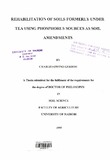| dc.description.abstract | Soil chemical factors responsible for stagnation and/or decline in yields of tea (C .
sinensis L.) failure of alternative crops such as field bean (p. Vulgaris L.) to establish in
former tea soils and their amendments with phosphorus sources were investigated in
laboratory, greenhouse and field studies. Ando humic nitisols from four sites, viz., fields
with moribund tea, teas planted in 1959 and 1979 and newly cleared forest in Kagaa, Lari
Division, Kiambu District, Kenya were used. High aluminium (Al3+) concentration and
saturation (> 480 g kg -1), deterioriation of soil nutrients balance, low phosphorus (P)
content and high P - fixation capacity were found to be the most probable detriments.
The addition of triple superphosphate (TSP) and Minjingu phosphate rock (NlPR)
fertilizers at rates 0 (Control), 30, 45 and 60 kg P ha-1 and 30 kg P ha -1 as TSP plus lime
(CaC03) to the soils as sources ofP and soil ameliorants and incubating for 1,7,14 and 28
days showed that TSP and 30 kg P ha-1 (TSP) plus lime significantly increased Ca2
+ and P
and decreased AP+ contents more than NlPR did within one day of application. NlPR
significantly increased the soil reaction, Ca2
+ and P and decreased Al3
+ contents gradually
within 14 days. The differences between the P sources was attributed to the higher solubility
of TSP and also its ability to supply more P to the soils which reacted with Al3+ to form
sparingly soluble compounds.
The yields of field beans grown on the soils studied were also significantly increased
by TSP and 30 kg P ha-1 (TSP) plus lime more than NlPR fertilizer did when the above
stated rates ofTSP and NlPR fertilizers and 30 kg P ha-1 (TSP) plus iime were added to the
soils. The differences were attributed to the abilities of the sources to supply sufficient
quantities of P to satisfy both the soils high P-fixation capacities ans also for the plant
growth.
Incorporating field bean tops (shoots) into the soils significantly increased the yield
of subsequent field bean crop. The yields were also significantly increased when the above
stated P sources were also added to the soils incorporated with field bean tops. Significantly
higher increases were found when TSP and 30 kg ha-1 (TSP) plus lime were applied than
with MPR fertilizer. This was attributed to low C:N (6.3) and lignin:N (1.3) ratios, low
polyphenolic (2.7g kg -1) and high N (50A g N kg -1) contents of the bean plant. These
enabled it to decompose rapidly thereby releasing both N and other essential plant nutrients
to the soil for plant growth. The ability of TSP and 30 kg P ha -1 (TSP) plus lime to
dissolve quickly and supply P to the soils which is good for higher microbial events led to
the observed higher yields.
Agronomically, TSP fertilizer was found to be superior to MPR as a source of P
and also as a soil ameliorant for growing field bean in soils formerly under tea. This is
because the former releases P more quickly thereby reducing the soil's high P-fixation
capacity and also supplying highly deficient P for plant growth in the soil.
The yield responses of tea (Camellia sinensis L. O'Kuntze) to 30, 45 and 60 kg
P ha-1 ofTSP and MPR fertilizers, 30 kg P ha -1 (TSP) plus lime (Ca C03) and 25:5: 5:5
NPKS fertilizer (Control) in moribund tea and 1979 planted tea fields were statistically not
significantly different because of " the complexation of AI" tolerance mechanism of the tea
plant to high AI and low P content soils. Through this mechanism, the uptake of both P and
Ca2+ by the tea plant is insignificantly reduced.
In conclusion the study showed that for the tea plant, all the P - sources used are
effective as sources of P but for the purpose of rehabilitation of moribund tea fields and
also for sustainable productivity, 30 kg P ha-1 (TSP) plus lime and MPR should be preferred
because they reduce the high soil acidity, AI content and saturation and also increases the
available P content in the soil. This will reduce AI build up in the plant tissues which exerts
stress on the plant and eventually leads to the decrease in the plant's resistance to
opportunistic diseases and such as Armilaria melea and Hypoxylon serpens hence
vacancies and reduced yields | en |

